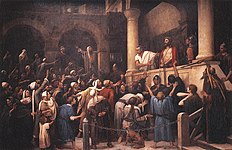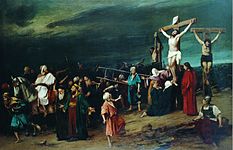Déri Museum
The Déri Museum ( Hungarian : Déri Múzeum ) is an art and folklore museum in the eastern Hungarian city of Debrecen . Its main building is located on Déri Square ( Déri tér ) of the same name in the center of the city.
history
When it opened in 1902 , the Déri Museum was still primarily a museum of urban history. A donation from the Debrecen jeweler Artúr Löfkovics formed the basis of the museum, but other citizens of the city also donated exhibits to the museum at the time in order to document the history of the city for the public. In 1920 the Debrecen silk manufacturer Frigyes Déri (1852–1924) donated his extensive private collection of Hungarian and Far Eastern art and cultural objects to the museum.
The main building, designed by the Hungarian architects Dénes Györgyi and Aladár Münnich in the neo- baroque style, was constructed between 1923 and 1929 and reopened as the Déri Museum in 1930 . In 1938 the museum received a no less important collection from Frigye's brother György Déri , consisting of various folk art objects from the Carpathian Basin. Since then, local ethnographers, historians, and archaeologists have helped expand the collection.
The museum is run by the Hajdú-Bihar County Museum Directorate .
Collections
In addition to the archaeological, urban history, local history, folklore and art history collections, the collections of the Déri Museum also include a natural history collection. The collections consist of nine permanent exhibitions: City History, the Munkácsy Group, the Déri Collection, “Our Birds”, a mineral collection , the gallery of old masters, the gallery of modern art, a glass, ceramic and porcelain collection and a collection of Egyptian and Greco - Roman art .
Four cast iron sculptures by the Hungarian sculptor Ferenc Medgyessy won the Grand Prize at the Paris World Exhibition in 1937 and are displayed in front of the main building of the museum.
Christ trilogy
The most important exhibits of the collection of fine arts are the two works of the Christ Trilogy by the Hungarian painter Mihály Munkácsy exhibited in the Munkácsy room . The colossal paintings “ Ecce Homo ”, “Christ before Pilate” and “ Golgotha ”.
See also
Individual evidence
- ↑ Déri Museum , museum.hu, accessed 8 April 2012
- ↑ Tourism brochure (PDF file; 3.60 MB), p. 5, City of Debrecen, 2007
Web links
- www.derimuz.hu (Hungarian)
Coordinates: 47 ° 31 ′ 58 ″ N , 21 ° 37 ′ 20 ″ E




